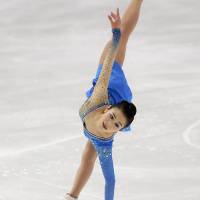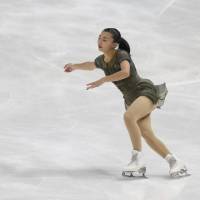What a difference a couple of weeks makes.
After the NHK Trophy in Osaka earlier this month, three-time national champion Satoko Miyahara's hopes of making Japan's team for the Pyeongchang Olympics looked in dire straits.
Back in competition for the first time in nearly 11 months after a serious hip injury, Miyahara finished a disappointing fifth while being plagued with under-rotations on her jumps. The outlook was very grim, to say the least.
But it was a different story over the weekend at Skate America in Lake Placid, New York. Miyahara won both the short program and free skates on the way to an important victory for her as the time for the Olympic team selection draws closer.
Miyahara prevailed with a total score of 214.03 points, while teammate Kaori Sakamoto came in second at 210.59.
The result put Wakaba Higuchi into the Grand Prix Final in Nagoya next month and makes Miyahara the first alternate. With two-time world champion Evgenia Medvedeva nursing a broken metatarsal in her right foot, it makes very real the possibility that the Russian will have to withdraw and Miyahara will get the ticket into the GP Final.
After the NHK Trophy the possibility of Miyahara making the GP Final seemed nearly fantasy. So now the waiting game begins.
Three-time U.S. champion Johnny Weir, commenting on NBC, cited the importance of being in the GP Final field this season.
"The Grand Prix Final is a prestigious event every year, but an Olympic year it is so important to be thought of as one of the best six through the fall season heading into Olympic qualification competitions for all the countries," Weir stated.
While Miyahara's triumph was encouraging, it must be put into context. She prevailed over a lineup that was mediocre at best. Medvedeva, Alina Zagitova, Kaetlyn Osmond and compatriots Mai Mihara and Marin Honda were not in the field.
The question now is whether this is a definite sign of progress for Miyahara or just a one-off?
"I am very happy and satisfied with today's performance and to get my best scores," Miyahara was quoted as saying by the ISU website. "After the injury, this is the first big step. The most important event, the Japanese nationals, are coming next month. I'll keep working hard to be able to do my best."
Of more significance is whether she has truly put the hip injury behind her, because if that flares up again it will change everything.
Weir expressed concern that Miyahara may be overtraining and could reinjure herself.
"She was drilling yesterday in practice, doing her combinations over and over and over again," Weir commented while analyzing Miyahara's short program to "Memoirs of a Geisha."
"While that is beneficial on things like the step sequence, the beautiful spins she does in rehearsal at practice definitely make those elements better. The jumps, especially coming back from injury, I felt she was doing way too much."
Miyahara's jumps have long been a topic of conversation in the skating community. Skate America was no different.
"In the short program, ultimately, she came out with some of the worst jumps I have seen from her," Weir stated. "But I felt really that the short program was very interesting, it showed her in a different light. I felt this choreography, this music brought out some fire in her."
Nagano Olympic champion Tara Lipinski praised Miyahara's artistry in the short program.
"One of my favorite skaters to watch. So lyrical, so gentle on the ice," Lipinski said. "A beautiful artist, and tonight she pulled out the jumps.
"She had such a terrible Grand Prix before coming into this one and I think a lot of people started to count her out. But we watched her practice jump after jump. She was training so hard, she knew she could do it.
"She has such a soft, delicate style on the ice. Her jumps, she really forces them so she doesn't get a lot of height."
Weir praised Miyahara's ambidexterity with her spins in her free skate to "Madame Butterfly."
"Extremely difficult to spin in both directions," Weir commented. "It's like you writing with your right hand and then switching to your left."
Weir cited Miyahara's consistency as being one of her strong points.
"There is something that is very rehearsed and you know what you are going to get with Satoko," he stated. "If she skates one way in practice, she's most likely going to skate that way in the competition, almost like a ballerina rehearsing for spots and hitting her marks every time."
Eurosport's Mark Hanretty had high praise for the Kyoto native's presentation skills.
"From a program component perspective, I adore her skating," Hanretty commented. "So elegant, so classy and beautiful in her delivery. Really, really enjoyable to watch."
Hanretty loved Miyahara's huge spiral in her free skate.
"This is what makes her so wonderful to watch," he said. "Look at the commitment to that position. Just fantastic."
Weir wondered if the judges were giving Miyahara a bit of an edge with their scoring on her jumps.
"The technical panel, I felt like they were a little bit soft on her," Weir stated. "They were definitely lenient on many of her jumps. But the fact that she was able to deliver, I think that is what led to that leniency."
Sakamoto takes home silver
Sakamoto made a great impression on observers with her skating in New York, where she achieved new personal bests for the short program, free skate and total score. It was a big improvement from her fifth-place finish at the Cup of Russia last month.
"After I was not satisfied with the Russian Grand Prix, I practiced so hard for a few weeks and this second try (here) gives me confidence for the future," Sakamoto told the ISU website. "In the short program, I did a mistake on the spin and I have so much room to improve my performance — the jumps, the spins and the grade of execution."
Ice Time has admired Sakamoto since first seeing her skate at the Junior Grand Prix event in Nagoya back in 2014. Kaori is blessed with both great ability and confidence. Most importantly, she has guts and really goes for it with her skating.
I have been telling other media folks to keep their eyes on her the past few seasons.
Lipinski highlighted the 17-year-old's triple flip/triple toe loop combination in her short program to "Moonlight Sonata."
"Very solid. Gorgeous," Lipinski said.
Weir pointed out the balance in Sakamoto's jumps.
"She is so evenly matched. The height and the speed of rotation are so beautiful to watch," he commented.
While reviewing her free skate to "Amelie," Lipinski said Sakamoto's landings reminded her of another Japanese skating legend.
"She is such a talented jumper," Lipinski stated. "Her landings are very reminiscent of Midori Ito. That deep knee bend."
Weir was completely won over by Sakamoto's free skate.
"Kaori's skating is so brilliant and smooth and elegant. It's like crushed velvet," Weir commented. "It was really beautiful technically and I really enjoyed the components of that program."
Most enjoyable was watching Sakamoto's joyous reaction after finishing her free skate and when she saw her scores. That kind of enthusiasm is truly authentic and precious.
Joy watching juniors in action
Ice Time had a wonderful weekend covering the Japan Junior Championships in Maebashi, Gunma Prefecture. It has quickly turned into my favorite event of each season.
The young skaters are such a joy to be around. Full of energy and enthusiasm and free of the cynicism that comes with age.
The beauty of the competition each year is how the skaters, media and fans are literally all mixed in together. People just milling about and watching their favorite sport. You never know who you will bump into.
Mako Yamashita, who finished second, made my day after Friday's draw when I was taking her picture. She told me, "I remember you from last year." I saw her several more times during the weekend and she made eye contact and smiled each time.
Rika Kihira's superb performance in rallying to win the title on Sunday night with two titanic triple axels brought back memories of the 2008 GP Final in South Korea, when Mao Asada came back to beat Yuna Kim with two huge triple axels of her own.
That was immediately what I thought of when the final results were known.
Kihira's performance was admirable in the wake of great expectations. The 15-year-old is one of just eight women in skating history to land a triple axel in international competition.
What is interesting to note is that four of those eight are Japanese (Ito, Mao, Yukari Nakano and Kihira) and one is Japanese-American (Mirai Nagasu).
Yamashita is another skater who Ice Time identified early as having great potential. She seems to almost always end up on the podium.
In the four events in her two seasons on the JGP circuit, the 14-year-old from Nagoya has earned four medals. She is currently the first alternate for the JGP Final next month.
Yamashita held an eight-point lead over Kihira going into Sunday's free skate at Gunma Ice Arena, but was unable to hold on in the wake of Kihira's fierce comeback. But Yamashita left with her head held high despite coming up three points short of the title.
The biggest revelation of the weekend in Gunma was definitely 15-year-old Tomoe Kawabata from Tokyo. A relative unknown, she was third in the short program on Saturday and was absolutely scintillating in a beautiful white outfit.
The second of the 30 skaters in the short program, Kawabata's score remained atop the leaderboard almost until the end of the night.
Kawabata, who is mentored by Shoichiro Tsuzuki, who was Yuzuru Hanyu's first coach, ended up sixth after the free skate, this time in a brilliant yellow costume, but made quite the impression on everyone in attendance.
With many wondering who Kawabata was, Ice Time did a little research and found that she was 27th in the short program in the event last season in Sapporo. With only the top 24 advancing to the free skate, she didn't get the chance to take the ice.
It seems very unlikely that is going to happen again anytime soon.


















With your current subscription plan you can comment on stories. However, before writing your first comment, please create a display name in the Profile section of your subscriber account page.